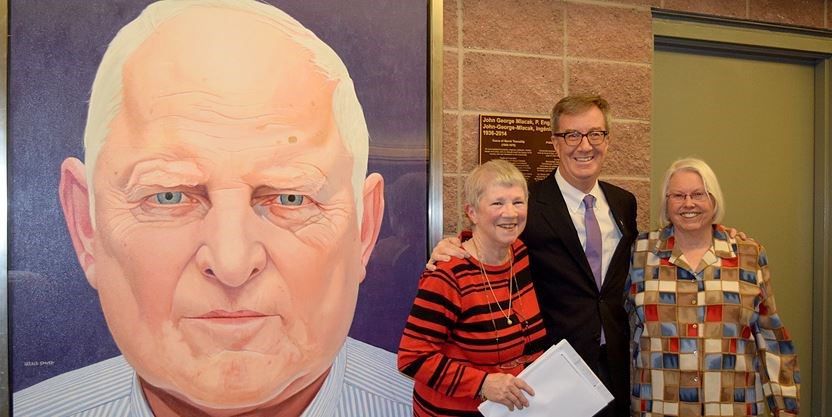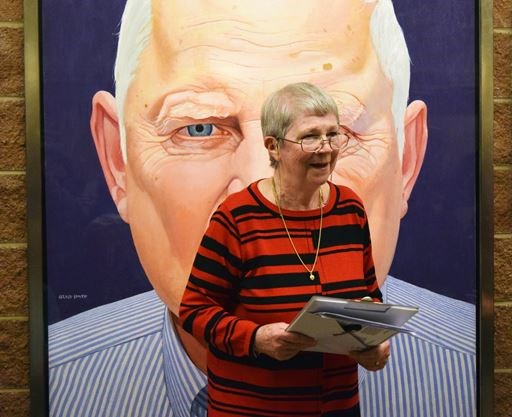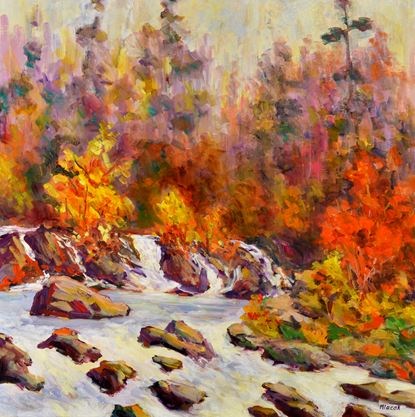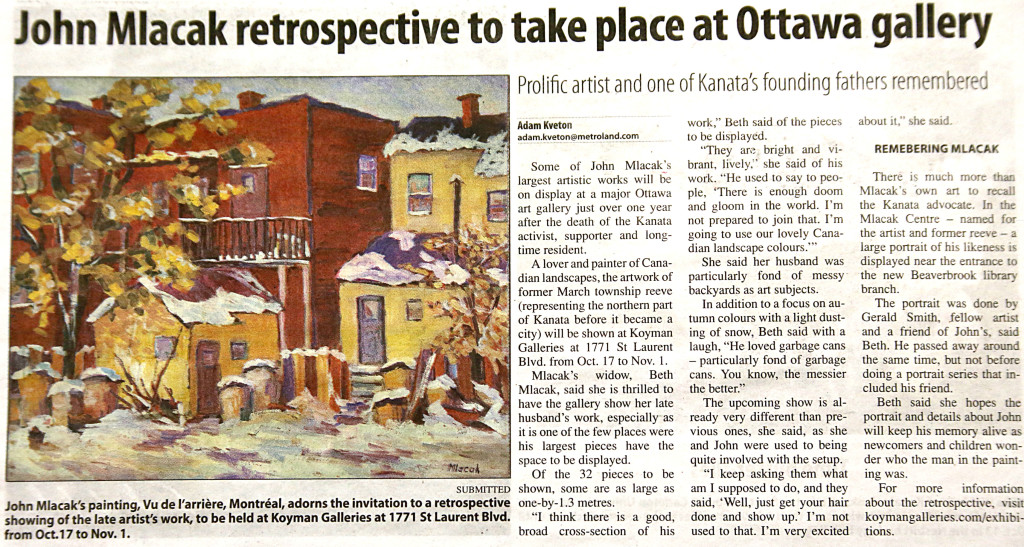A founding father of Kanata, former reeve ‘was dedicated to his community’
From OttawaCommunityNews.com by Jessica Kunha, Kanata Kourier-Standard, 11/15/2017

From left, Beth Mlacak, Mayor Jim Watson and Coun. Marianne Wilkinson unveil a plaque next to a large portrait of the late John Mlacak in the building that bears his name. The plaque lists John’s many accomplishments and his impact on the development of Kanata. – Jessica Cunha/Metroland
People who walk by the large portrait of John Mlacak in the centre that bears his name will now have the opportunity to learn a little more about the man who is considered one of the founding fathers of Kanata.
His widow Beth Mlacak, Kanata North Coun. Marianne Wilkinson and Mayor Jim Watson unveiled a plaque next to the portrait, located in the main entrance hall of the John G. Mlacak Centre, on Nov. 14. Dozens of friends and former colleagues attended the dedication ceremony.

Beth Mlacak, the widow of the late John Mlacak, thanks the people involved in creating a plaque that details John’s impact on Kanata. Former March township reeve, John is considered one of the founding fathers of Kanata. – Jessica Cunha/Metroland
“An accomplished humanist, engineer, politician, mentor, leader and artist, John G. Mlacak loved the beauty of his country and was dedicated to his community,” said Beth, reading the words inscribed on the plaque.
Previously, only an identification sign gave any indication as to who was depicted in the painting and why. Beth was instrumental in getting the more detailed plaque installed, which outlines the impact her late husband had on the community of Kanata. Her adult children Bill, Kirsten and Siobhan also helped with the wording in English and French.
Mlacak, who died in 2014, held many titles; he was a professional engineer by trade, reeve of the former March township from 1968 to 1976, regional commissioner of the National Capital Commission for three years and a renowned professional artist.
One of the first 10 families to settle in the Beaverbrook area, he got involved in municipal politics “almost immediately,” said Wilkinson, adding he was her mentor when she was elected to the former township council.
He helped bring garbage and recycling collection to Kanata, and was heavily involved in developing other services in the area, including seniors housing, a child care centre, a combined fire hall and library, as well as the first municipal business park.
Wilkinson recalled how the former township council was able to name the building after Mlacak without him knowing.
“He was reeve at the time. He had to go to a regional meeting downtown and the other four members of council were meeting without him; he hadn’t gotten back yet. We said, ‘This is a good time, we should name something after John,’” she said.
“He did an awful lot of work to get this building going so we put a motion forward and passed it. Then he came in and we told him.”
Mlacak was “really annoyed” by the approved motion, telling the council there were other people who deserved to have a building named for them, she said. But secretly, “I think actually he was pleased as punch.”
The late Gerald Smith, a fellow artist and friend, created the portrait of Mlacak. Kirsten donated it to the city after her father’s death and it was hung in the centre.
“I had the honour of knowing John and what he did for the community both as an elected representative, as a member of the NCC and as a great artist,” said Watson, who presented Mlacak with the Lucille Broadbent Award for Artistic Achievement in 2010. “He’s an individual who’s never looking for credit or accolades but quietly did the work behind the scenes to help make this part of the city the special place it is.”
‘Never seen’ work on display Sept. 30 to Oct. 16
From OttawaCommunityNews.com by Jessica Kunha, Kanata Kourier-Standard, 9/22/17

Koyman Galleries will host an exhibit of John Mlacak’s work, some completed shortly before his death three years ago. The showing takes place from Sept. 30 to Oct. 16. Pictured is an oil on canvas by Mlacak, titled ‘Chute du Diable.’ – John Mlacak/Courtesy Beth Mlacak
Some never-before-seen works by the late artist John Mlacak will be on display at an Ottawa art gallery.
Koyman Galleries, in the city’s east end, will display around 30 of Mlacak’s oil paintings — from the very small to the very large — in an exhibit titled Reflections, from Sept. 30 to Oct. 16.
The former March township reeve, who died in Sept. 2014, always had new art work on the go and was often working on two- to three-dozen at a time, said his widow Beth Mlacak.
“There’s going to be (paintings) for people who think they’ve seen everything, that they have never seen before,” she said. “This will be different.”
After his death, Koyman Galleries stored the entirety of Mlacak’s work and hosted a retrospective in 2015.
“It was so successful on many levels; it was very well attended, but even more so, the exhibition sold many pieces that showed that his work really moved many people,” said gallery manager Eddie Baroud.
“We decided to show his work again, new pieces that had never been displayed before. One reason was to show clients his vast array of works that he painted, as well as to meet the demand for his work.”
Mlacak always had time for anyone who wanted to speak with him and often showed up at the gallery with treats in hand.
“John’s connection in the community was pretty amazing. He was well-liked by many and had an amazing reputation in the art community,” said Baroud.
“He was a very patient and generous man; patient, to discuss his work any time and tell his stories about the composition and the location of his subject matters.”
Mlacak most enjoyed capturing Canadian landscapes with his brush, particularly when fall colours met early snow.
“He just loved that — the wonderful golds and reds popping through the snow,” said Beth. “It’s hard to look at his paintings and not see how much he loved (Canada), how much the country had to offer in terms of beauty. You can just see he brought it forward.”
Many scenes in his works are recognizable — trees along the Old Carp Road, a garden in the Glebe, and a lake in the Gatineau Hills. Other paintings take the viewer on a trip to far-flung destinations such as France and Italy.
“He painted scenes and places that people felt a connection to. And if they didn’t know the location, his paintings took you there,” said Baroud. “He achieved what he was trying to do.”
Aside from his oil paintings, Mlacak was well known for his community activism and 11-year political career, and is considered one of Kanata’s founding fathers.
He continued to advocate for his Beaverbrook community leading up to his death, pushing back against proposed intensification and developments that didn’t fit the vision.
An elected member of the Society of Canadian Artists and the Ontario Society of Artists, Mlacak’s artistic career spanned more than three decades.
“John is pretty well-known in Ottawa. He has a very loyal and fond following,” said Beth, who will be at the exhibit on Sept. 30 and Oct. 1.
“It’s very gratifying for me to see it so professionally displayed — that’s what any artist would wish for. It’s really wonderful.”
Koyman Galleries is located at 1771 St. Laurent Blvd. For more information, visit koymangalleries.com or call 613-526-1562.

Pignons sur l’arrière-cour
Oil on stretched gallery canvas – 20″x 24″ – Landscape/Horizontal – Catalogue #1552
One summer, several years ago, I cycled and drove up and down back alleys and lanes in both Montreal and Toronto looking for painting opportunities. Almost every space had a garage, shed or high fence making a view of buildings in back yards almost impossible.
While visiting my brother in Toronto more recently, I investigated The Annex adjacent to the University of Toronto searching for a potential client’s original home as subject matter for a painting. This exposed me to a part of Toronto known as Chinatown.
There were no long alleys, but rather parking areas leading to the backs of homes with unique roof lines, open back yards, many varied outbuildings and lots of clutter. The area had a fair amount of late snow still resting on anything that would support it.
I had found a gold mine of painting opportunities. I spent the day photographing numerous back parking spaces.
Once home, I did many sketches of various urban configurations and found myself excited at the prospect on creating an entirely new series of oil paintings. As for painting style, I focussed on texture, colour contrast, looseness and random architecture in order to capture the effect the area had on me during my visit.
“Pignons sur l’arrière-cour” is among my favourites that evolved from my “house series”. It captures all that I was searching for in terms of back yard urban settings. It evokes a certain mystery, tranquillity and a slowing down of time.

View from the bridge on Rue Turenne over the river Lauch in the quarter called “La Petite Venise” in Colmar
Colmar, France – Oil on stretched canvas – 40” x 50” – Landscape/Horizontal – Catalogue #1582
Colmar is in the eastern part of France, south of Strasbourg near the German and Swiss borders.
My daughter, who lives in Paris, visited Colmar. She was impressed with the beautiful scenery, especially the architecture of the half-timbered houses, and thought there was potential for one or more paintings.
As soon as I saw her photos, I knew I had to capture the images on canvas, and that the paintings would have to be large enough to do justice to the location. To me, the area was that of a storybook village. While working on the painting, I found myself wandering through the community, along the canal, smelling the flowers, observing the reflections in the canal, imagining myself in the rowboat, wondering what it would be like inside the homes, sitting on the tile rooftops watching life pass by and on and on. I had to regularly remind myself that this
place actually exits.
The setting is incredible…Franco-German residential architecture with a canal lined with trees and bushes, flowers, red tile-roofed buildings, etc. The beauty and serenity took over my imagination.
The painting style used is between impressionistic and representational. I wanted to create a personal sense of intimacy for the viewer, a feeling of belonging to the community, yet with enough detail to illustrate the unique architecture of Colmar.
View from the bridge on Rue Turenne over the river Lauch in the quarter called “La Petite Venise” in Colmar.
